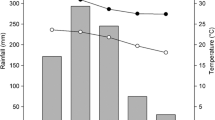Summary
As a result of air pollution, considerable deposition of ammonium sulphate occurs on vegetation and soil in the vicinity of chicken farms and fields dressed with animal slurry. A clear relation exists between this ammonium sulphate deposition and the distance to certain agricultural activities. Field investigations and ecophysiological experiments both show that the needles ofPinus nigra var.maritima (Ait.) Melville take up ammonium and excrete potassium, magnesium and calcium. This often results in potassium and/or magnesium deficiencies and may lead to premature shedding of needles. The high levels of nitrogen in the needles are strongly correlated to fungal diseases.
Whether the observed cation leaching will result in disturbed nutrient budgets depends mainly on soil conditions. Leaching of K, Mg and Ca from the soil, caused by ammonium sulphate, may further inhibit nutrient uptake.
Field investigations show a clear correlation between increased ratios of NH4 to K, Mg and Ca in the soil solution and the damage to pine forests.
Similar content being viewed by others
References
Aalst R M van 1984 Depositie van verzurende stoffen in Nederland.In Zure Regen: Oorzaken, Effecten en Beleid. Eds. E H Adema and J van Ham. Pudoc, Wageningen, 250 p.
Boer W M J den and Bastiaens H 1984 Verzuring door atmosferische depositie. Vegetatie. Publikatiereeks Milieubeheer. Ministry of Agriculture and Fisheries, Ministry of Housing, Physical Planning and Environment, The Hague, 82 p.
Breemen N van, Burrough P A, Velthorst E J, Dobben H F van, Wit T de, Ridder T B and Reynders H F R 1982 Soil acidification from atmospheric ammonium sulphate in forest canopy throughfall. Nature London 229, 548–550.
Breemen N van and Jordens E R 1983 Effects of atmospheric ammonium sulphate on calcareous and non-calcareous soils of woodlands in The Netherlands.In Effects of Accumulation of Air Pollutants in Forest Ecosystems. Eds. B Ulrich and J Pankrath. D. Reidel Publishing Company, Dordrecht, Boston, London, pp 171–182.
Grasshoff K and Johannsen H 1977 A new sensitive method for the determination of ammonia in sea water. Water Res. 2, 516.
Hunger W 1978 Über Absterbeerscheinungen an älteren Fichtenbeständen in der Nähe einer Schweinemastanlage. Beiträge f.d. Forstwirtschaft 4, 188–189.
Jacob A 1958 Magnesia, der fünfte Pflanzenhauptnährstoff. Ferdinand Enke Verlag, Stuttgart, 159 p.
Janssen Th W 1982 Intensieve veehouderij in relatie tot ruimte en milieu. State Forest Service, Utrecht, 54 p.
Kamphake L J, Hannah S A and Cohen J M 1967 Automated analysis for nitrate by hydrazine reduction. Water Res. 1, 205–206.
Klein T M, Kreitinger J P and Alexander M 1983 Nitrate formation in acid forest soils from the Adirondacks. Soil Sci. Soc. Am. J. 47, 506–508.
Krause G H M, Prinz B and Jung K D 1984 Untersuchungen zur Aufklärung immissionsbedingter Waldschäden in der Bundesrepublik Deutschland.In Zure Regen: Oorzaken Effecten en Beleid Eds. E H Adema and J van Ham. Pudoc, Wageningen, 250 p.
Kriebitzsch W U 1978 Stickstoffnachlieferung in sauren Waldböden Nordwestdeutschlands. Scripta Geobotanica, Erich Goltz, Göttingen, 66 p.
Nkonge C and Ballance G M 1982 A sensitive colorimetric procedure for nitrogen determination in micro-Kjeldahl digests. J. Agric. Food Chem. 30, 416–420.
Mulder E G 1956 Nitrogen-magnesium relationships in crop plants. Plant and Soil 7, 341–376.
O'Brien J 1962 Automatic analysis of chlorides in sewage wastes. Engineering 33, 670–672.
Roelofs J G M, Clasquin L G M, Driessen J M C and Kempers A J 1984 De gevolgen van zwavel- en stickstofhoudende neerslag op de vegetatie in heide- en heidevenmilieus.In Zure Regen: Oorzaken, Effecten en Beleid. Eds. E H Adema and J van Ham. Pudoc, Wageningen, 250 p.
Roelofs J G M, Schuurkes J A A R and Smits A J M 1984 Impact of acidification and eutrophication on macrophyte communities in soft waters. II. Experimental studies. Aquatic Botany 18, 389–411.
Technicon Auto Analyzer Methodology 1981 Industrial method 635-81W. New York, 8 p.
Tjepkema J D and Cartica R J 1981 Atmospheric concentration of ammonia in Massachusetts and deposition on vegetation. Nature London 294, 445–446.
Ulrich B 1983 Soil acidity and its relation to acid deposition.In Effects of Accumulation of Air Pollutants in Forest Ecosystems. Eds. B Ulrich and J Pankrath. D. Reidel Publishing Company, Dordrecht, Boston, London pp 127–146.
Author information
Authors and Affiliations
Rights and permissions
About this article
Cite this article
Roelofs, J.G.M., Kempers, A.J., Houdijk, A.L.F.M. et al. The effect of air-borne ammonium sulphate onPinus nigra var.maritima in the Netherlands. Plant Soil 84, 45–56 (1985). https://doi.org/10.1007/BF02197866
Received:
Revised:
Issue Date:
DOI: https://doi.org/10.1007/BF02197866




